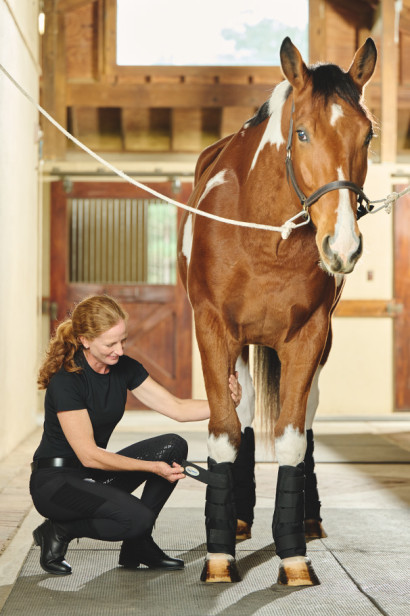Equine Therapy for Injury Healing: How Steeds Assist Heal Emotional Wounds
Wiki Article
Examining the Efficiency of Laser Treatment in Horse Therapy for Injury Rehab
The analysis of laser therapy's efficiency in equine injury recovery depends upon numerous elements, including recovery time, pain mitigation, and tissue regeneration. Clinical research studies recommend remarkable improvements in conditions like tendonitis and osteoarthritis, attributed to boosted cellular feature and raised ATP manufacturing. Veterinarians often observe superior end results with laser treatment compared to standard methods, positioning it as an essential component in equine care. However, the requirement for constant tracking and personalized therapy plans can not be overemphasized. What particular professional proof sustains these claims, and how do veterinarians execute these protocols in technique?Comprehending Laser Therapy
Laser treatment has come to be a critical device in veterinary medicine, particularly in the treatment of equine conditions. Recognized for its non-invasive nature and efficiency, laser treatment includes the application of details wavelengths of light to promote cells repair work and minimize swelling. This therapeutic technique is increasingly preferred for its capability to accelerate the recovery process in steeds struggling with a selection of bone and joint injuries and chronic conditions.The primary device behind laser treatment is its capacity to boost cellular features. When laser light penetrates the skin, it is absorbed by mitochondria, the powerhouse of cells, which brings about enhanced production of adenosine triphosphate (ATP) This biochemical energy increase helps with cellular repair and regeneration. In addition, laser therapy promotes vasodilation, improving blood flow and oxygen shipment to broken tissues, thus accelerating healing.
In equine medicine, laser treatment is specifically useful for problems such as tendonitis, osteoarthritis, and injury recovery. The method is admired for its pain-relieving buildings, permitting equines to restore movement and function extra swiftly. Veterinarians likewise appreciate its marginal adverse effects contrasted to various other treatment modalities, making it a trustworthy and secure option for equine treatment.

How Laser Treatment Works

Upon absorption, these photons trigger a collection of biochemical adjustments, improving mitochondrial function and bring about raised adenosine triphosphate (ATP) manufacturing. This surge in ATP accelerates cellular metabolic rate, advertising cells repair and regeneration. Furthermore, laser treatment modulates inflammatory reactions by influencing cytokine degrees and decreasing oxidative stress and anxiety, therefore alleviating pain and swelling.
An additional substantial element of laser therapy is its duty in enhancing microcirculation. The treatment advertises vasodilation, boosting blood flow and oxygen shipment to broken tissues (Equine Therapy). This assists in the elimination of mobile particles and sustains the spreading of fibroblasts and collagen synthesis, important for wound healing
Medical Proof
The efficiency of laser therapy in equine treatment has been substantiated via numerous professional researches, showcasing its healing prospective throughout browse around this site a variety of conditions. Numerous controlled tests and empirical research studies have recorded significant renovations in tissue repair work, pain decrease, and overall rehab timelines. As an example, a study carried out by Turner et al. (2012) demonstrated that steeds treated with low-level you could try this out laser treatment (LLLT) for ligament injuries showed increased recovery compared to those receiving conventional therapies. The research study highlighted a marked decrease in inflammation and boosted collagen development.In a similar way, research by Johnson and colleagues (2015) concentrated on equine muscle injuries, exposing that laser treatment considerably accelerated muscle fiber regrowth and decreased muscle rigidity. These searchings for were supported by histological evaluations showing better muscle cells company. Professional evaluations have actually revealed that laser treatment can relieve persistent conditions such as osteo arthritis. A research by Smith et al. (2018) reported that horses with osteoarthritic joints experienced remarkable discomfort relief and enhanced variety of motion complying with a program of laser therapy sessions.
Veterinarian Insights

Vets likewise appreciate the adaptability of laser therapy. She directs out that laser treatment can be tailored to the details demands of each steed, making sure optimum outcomes.
Furthermore, vets value the capability to integrate laser treatment with various other therapy techniques. This multimodal approach can enhance general therapy effectiveness, giving a comprehensive solution for equine rehabilitation. Such endorsements from skilled professionals underscore the growing approval and application of laser treatment in equine medication.
Practical Factors To Consider
A vital aspect of carrying out laser treatment in equine treatment entails understanding the useful considerations that guarantee its efficiency and safety. Firstly, it is important to pick the Equine Therapy appropriate laser gadget, as various types differ in wavelength, power, and infiltration deepness. Equine Therapy. Veterinarians need to be skilled in these criteria to customize therapy methods efficiently to each injury kindMoreover, the regularity and duration of laser treatment sessions require careful planning to optimize therapeutic benefits while lessening any type of possible adverse effects. Constant monitoring of the steed's reaction to treatment can guide required adjustments in the therapy routine. Establishing a secure and regulated atmosphere during therapies is additionally important to protect against unexpected exposure to laser discharges, which could damage both the steed and the trainer.
Training and qualification of personnel administering laser treatment are vital to ensure proper technique and to promote security criteria. In addition, preserving exact records of each session, including laser setups and observed results, is crucial for examining the overall effectiveness of the therapy and for making data-driven decisions.
Verdict
Laser treatment has actually become an effective modality in equine injury rehabilitation, offering substantial advantages in recuperation time, pain relief, and cells healing. Professional researches underscore substantial renovations in problems such as tendonitis and osteo arthritis, credited to boosted cellular function and boosted ATP manufacturing. Veterinarian monitorings affirm these searchings for, highlighting premium results compared to standard therapies. For optimal results, continual monitoring and personalized therapy methods remain crucial in leveraging the full potential of laser treatment in equine care.Report this wiki page